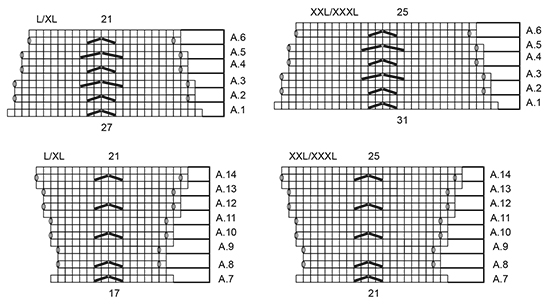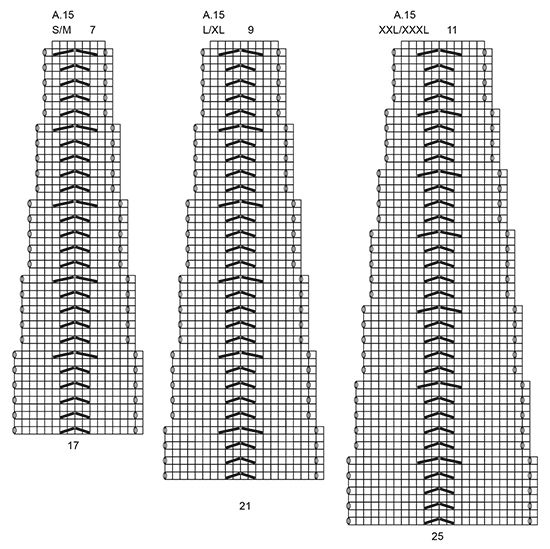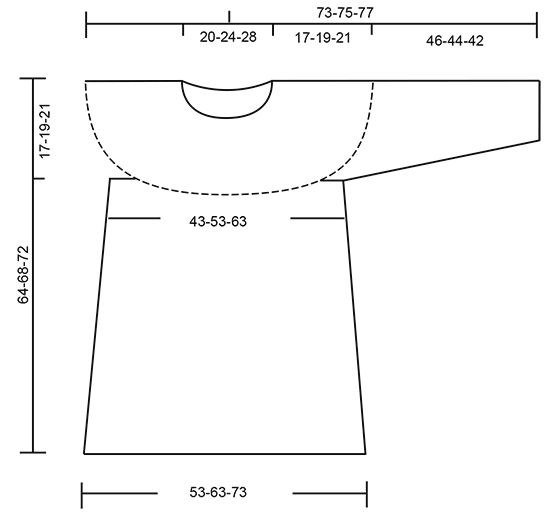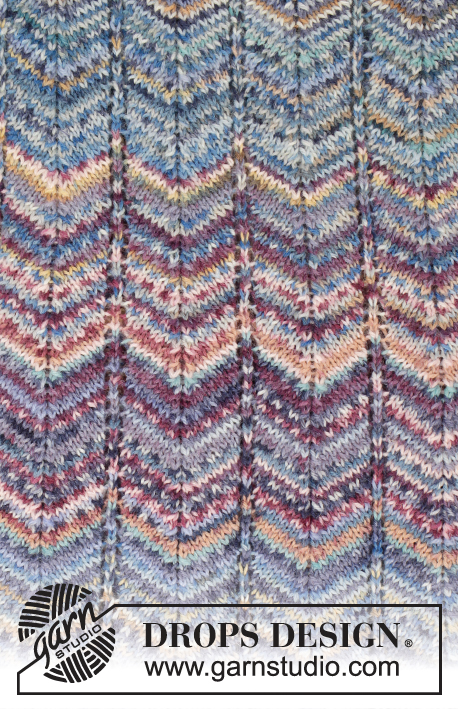Comments / Questions (32)
![]() Bozena wrote:
Bozena wrote:
Witam.Chcę zrobić ten sweter,ale chciałbym żeby był krótszy o jakieś 8-10 cm.Myslę zacząć od schematu A4 . Czy to będzie dobrze? Będę robiła roz S/M.I drugie pytanie,jak zrobić żeby po prostym ściągaczu 1/1 przejść do schematu zygzaka? Pozdrawiam Bozena
27.03.2025 - 14:55DROPS Design answered:
Witaj Bożeno, jak zaczniesz od A,4 to sweter będzie krótszy o jakieś 13 cm - jeśli zaczniesz od schematu A.4, to schemat A.5 zacznij o kilka cm wcześniej niż we wzorze. Drugie pytanie: ten wzór nie będzie dobrze wyglądał ze ściągaczem o jakim piszesz. Zacznij od ściegu francuskiego jak we wzorze. Pozdrawiamy!
28.03.2025 - 08:05
![]() Hanne wrote:
Hanne wrote:
Jeg kan ikke se logikken i mønsteret. Betegnelserne Å 1, A2 osv er ikke tydlige nok. Kan man få en løsning?
26.02.2025 - 17:31DROPS Design answered:
Hej Hanne, du starter nederst i diagrammet, sæt gerne 1 mærke imellem hver rapport, (på hver side af de 23 masker - i den mindste størrelse). Strik de 23 masker i diagrammet således 10 m ret, tag 1 m løst af p, 1ret, løft den løse over, 2 ret sammen (du har nu taget 2 masker ind), 9 ret. Nu starter du forfra og fortsætter med disse 23 m hele vejen rundt. På næste pind har du kun 21 masker i hver rapport :)
05.03.2025 - 15:10
![]() Ingvill wrote:
Ingvill wrote:
Hei skal A1 kun strikkes i en gang, mena A2 i flere cm? Strikker størrelse l/xl
12.11.2024 - 15:09
![]() Grete Gervig Jensen wrote:
Grete Gervig Jensen wrote:
Hejsa Jeg er i gang med at strikke denne flotte trøje, men jeg er i tvivl om, hvor man måler fra - skal man måle fra spidserne eller fra “kanten”. På forhånd tak 😊 Grete
29.10.2024 - 16:47DROPS Design answered:
Hej Grete, du skal måle fra spidsen :)
30.10.2024 - 11:12
![]() Gerda Jorna wrote:
Gerda Jorna wrote:
A1 over alle steken, 14 patroon herhalingen ..a1 is maar 2 naalden, daarna a2 weer 2 naalden dan kom ik toch niet op een hoogte van 14 cm? ( Maat L) En 14 patroon herhalingen x 17 steken , dan kom ik toch ook niet aan de 378 steken die ik op moet zetten? Begrijp dit patroon echt niet, help....
30.05.2024 - 18:29DROPS Design answered:
Dag Gerda,
De twee naalden van A.2 herhaal je dan steeds in de hoogte tot je de juiste lengte hebt bereikt.
30.05.2024 - 19:06
![]() Inge wrote:
Inge wrote:
Ich möchte diesen wunderschönen Pullover mit kurzen Ärmeln und klassischer Armkugel stricken. Wie funktionieren die Abnahmen im Zickzackmuster? LG
22.04.2024 - 12:52DROPS Design answered:
Liebe Inge, siehe vorrige Antwort, für kurze Ärmel lassen Sie sich von einem ähnlichen Modell mit kurzen Ärmel mit derselben Maschenprobe inspirieren. Viel Spaß beim Stricken!
22.04.2024 - 13:16
![]() Inge Frigl wrote:
Inge Frigl wrote:
Ich möchte diesen wunderschönen Pullover nicht mit Rundpasse sondern mit Armkugel stricken. Wie funktionieren die Abnahmen im Zickzackmuster? LG
22.04.2024 - 12:50DROPS Design answered:
Liebe Frau Frigl, hier finden Sie Pullover, die mit angenähte Ärmel mit Zickzack-Muster gestrickt werden, hoffentlich kann das Ihnen helfen. Viel Spaß beim Strickn!
22.04.2024 - 13:15
![]() Marianne Colpaert wrote:
Marianne Colpaert wrote:
Ik wil de trui korter maken. Op welke hoogte in de telpatronen begin ik dan met de minderingen? Van onder de arm gemeten wil ik een maximum lengte van 45 cm. En kan ik de mouwen ook breien op een korte rondbreinaald ipv op Naalden zonder knop? Alvast bedankt voor een antwoord van jullie. Ik ben maar een beginnende breister op rondbreinaalden.
08.11.2023 - 00:43DROPS Design answered:
Dag Marianne,
Je breit 14 patroonherhalingen in de breedte. Om de trui korter te maken zou je kunnen starten met een patroon later in de beschrijving en je zet dan minder steken op, afhankelijk van hoeveel steken er in de breedte zitten in de patroonherhaling op dat moment en afhankelijk van welke maat je breit.
13.11.2023 - 06:42
![]() Anette wrote:
Anette wrote:
Hvis jeg gerne vil strikke den flotte bluse et nr./lidt større, hvordan gøres det så nemmest i forhold til maskeantal/mønster? Jeg vil rigtig gerne i gang med at strikke den, så håber på hurtigt svar, ved godt at I sikkert har ganske travlt.
26.06.2021 - 03:26DROPS Design answered:
Hei Anette. Design avd. har dessverre ikke anledning til å omregne denne til en større størrelse. Det er ikke bare å legge til flere masker, denne genseren har flere diagrammer man også må ta hensyn til. mvh DROPS design
28.06.2021 - 13:43
![]() Anna wrote:
Anna wrote:
Jag undrar över storlekarna. I S/M är måttet över bysten 43 cm, det verkar smått även för en ren storlek S?
27.03.2021 - 09:12DROPS Design answered:
Hej Anna, de 43 cm er bredden, så når du ganger med 2 får du omkredsen :)
07.04.2021 - 10:18
At Sundown#atsundownsweater |
|||||||||||||||||||
|
|
|||||||||||||||||||
Knitted DROPS jumper with zig-zag and round yoke in “Fabel”. Size: S - XXXL.
DROPS 168-19 |
|||||||||||||||||||
|
GARTER ST (worked in the round): 1 ridge = 2 rounds. * K 1 round and P 1 round *, repeat from *-*. PATTERN: See diagrams A.1 to A.15. See diagram for size! STRIPES BODY: Work as follows: * 2 rounds turquoise/blue, 2 rounds lavender *, repeat from *-* for 8-8-9 cm / 3"-3"-3½". * 2 rounds lavender, 2 rounds sea mist *, repeat from *-* for 8-8-8 cm / 3"-3"-3". * 2 rounds sea mist, 2 rounds turquoise/blue *, repeat from *-* for 7-8-8 cm / 2 3/4"-3"-3". Repeat these 23-24-25 cm / 9"-9½"-9 3/4" upwards. STRIPES SLEEVE: * 2 rounds turquoise/blue, 2 rounds lavender *, repeat from *-* for 8-8-7 cm / 3"-3"-2 3/4". * 2 rounds lavender, 2 rounds sea mist *, repeat from *-* for 8-7-7 cm / 3"-2 3/4"-2 3/4". * 2 rounds sea mist, 2 rounds turquoise/blue *, repeat from *-* for 7-7-7 cm / 2 3/4"-2 3/4"-2 3/4". Repeat these 23-22-21 cm / 9"-8 3/4"-8 1/4" 1 more time. ---------------------------------------------------------- BODY: Worked in the round from mid back. Cast on 322-378-434 sts on circular needle size 3 mm / US 2.5 with turquoise/blue. Work STRIPES BODY - see explanation above. Work 1 ridge in GARTER ST - then work A.1 over all sts (= 14 repetitions in width). REMEMBER THE KNITTING GAUGE When A.1 has been worked one time vertically, there are 294-350-406 sts on needle. Continue with A.2 over A.1. When piece measures 13-14-15 cm / 5"-5½"-6", work A.3 over all A.2, when A.3 has been worked one time vertically there are 266-322-378 sts on needle. Continue with A.4 over all A.3. When piece measures 29-31-33 cm / 11½"-12 1/4"-13", work A.5 over all A.4. When A.5 has been worked one time vertically, there are 238-294-350 sts on needle. Continue with A.6 over A.5 until piece measures 47-49-51 cm / 18½"-19 1/4"-20". Now work as follows: Work the first 51-63-75 sts (= half back piece), bind off the next 17-21-25 sts, work the next 102-126-150 sts (= front piece), bind off the next 17-21-25 sts, work the last 51-63-75 sts (= half back piece). Put piece aside and knit the sleeves. SLEEVE: Worked in the round on double pointed needles. Cast on 65-85-105 sts on double pointed needles size 3 mm / US 2.5 with turquoise/blue. Work STRIPES SLEEVE. Work 1 ridge in GARTER ST – see explanation above, then work A.7 over all sts (= 5 repetitions in width). When A.7 has been worked one time vertically, there are 55-75-95 sts on round. Continue with A.8 over all sts. When piece measures 11-11-11 cm / 4½"-4½"-4½", work A.9 over all sts. When A.9 has been worked one time vertically, there are 65-85-105 sts on round. Continue with A.10 over all sts. When piece measures 22-24-26 cm / 8 3/4"-9½"-10 1/4", work A.11 over all sts. When A.11 has been worked one time vertically, there are 75-95-115 sts on round. Continue with A.12 over all sts. When piece measures 34-33-32 cm / 13½"-13"-12½", work A.13 over all sts. When A.13 has been worked one time vertically, there are 85-105-125 sts on round. Continue with A.14 over all sts. When piece measures 46-44-42 cm / 18"-17 1/4"-16½" (shorter measurements in the larger sizes because of longer yoke), bind off the first 17-21-25 sts (= one repetition of A.14) = 68-84-100 sts. Make another sleeve the same way. YOKE: Slip sleeves on to same circular needle 3 mm as body = 340-420-500 sts. Then work according to A.15 (= 20 repetitions in width), continue with STRIPES BODY work and dec according to A.15. When A.15 has been worked one time vertically, there are 140-180-220 sts on needle. Work 2 ridges in garter st, on first round in first ridge dec 35-55-75 sts evenly = 105-125-145 sts. Bind off. Piece measures approx. 64-68-72 cm / 25 1/4"-26 3/4"-28½". ASSEMBLY: Sew the openings under the sleeves. |
|||||||||||||||||||
Diagram explanations |
|||||||||||||||||||
|
|||||||||||||||||||

|
|||||||||||||||||||

|
|||||||||||||||||||

|
|||||||||||||||||||

|
|||||||||||||||||||
Have you finished this pattern?Tag your pictures with #dropspattern #atsundownsweater or submit them to the #dropsfan gallery. Do you need help with this pattern?You'll find 23 tutorial videos, a Comments/Questions area and more by visiting the pattern on garnstudio.com. © 1982-2025 DROPS Design A/S. We reserve all rights. This document, including all its sub-sections, has copyrights. Read more about what you can do with our patterns at the bottom of each pattern on our site. |
|||||||||||||||||||

































































Post a comment to pattern DROPS 168-19
We would love to hear what you have to say about this pattern!
If you want to leave a question, please make sure you select the correct category in the form below, to speed up the answering process. Required fields are marked *.